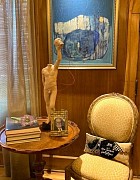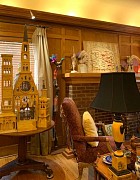



Blog: Who Are You?
June 18, 2020 - Joy Reed Belt
The door to my office at the Gallery has glass panes. Often when looking up from my desk, I will see a nose or two pressed to a pane of glass. At that point I usually get up, walk to the door, and ask if I can be of assistance. Inevitably I get the question, “Is this room part of the Gallery?” When I reply, “it’s my office,” the response is surprise, a request for permission to enter, and comments that this is the most unusual office they have ever seen.
I readily acknowledge that my office is probably the most “eccentric” office in Oklahoma City. By that point in the conversation, my visitor(s) will spot a painting or an object that they want to ask about, such as two six foot handcrafted bird cages by Nick Irza, one in the style of a Cathedral and the other in the style of a Russian Orthodox Church, that sit on either side of my fireplace. In truth, everything in my office has a story and every piece of art, furniture, book, or paperweight has long since become a part of me. When visitors are interested, I take time to relate my history with the item and why I selected it to be in my office. During this artistic version of “show and tell” the visitor finds out a lot about me, my background, my aesthetic, my belief system, and my philosophy of life. They, in turn, start telling me what my object reminds them of, usually something they love. Often, they will pull out their cell phone and show me pictures of things that are meaningful to them. Art gives us the vocabulary to truly communicate and share our authentic selves.
I was again impressed with power of art to communicate one day last week when I visited two different medical offices in another city. The principal providers in both offices had been highly recommended and my research confirmed they were indeed recognized experts in their given fields.
Upon entering the first office, being the visual person that I am, I began evaluating the office and its services based on what I could see. Overall, it was a tasteful, gracious, and decorated office which generated the subliminal message that its clients, 90% of which are female, were special. The walls and upholstered furniture were done in neutral colors and fabrics. The light fixtures, pillows, and accessories were decorative and enhanced with touches of gold. The background music was soothing, and the staff was welcoming and professional. I started to relax a bit and to feel that I had come to the right place.
Then I turned and saw a huge black painting hanging on the wall behind me. Upon inspection the painting turned out to be created with spray paint on styrofoam. It was so out of character for that space that I was shocked. Seeing my reaction, one of the staff said: “Isn’t that painting awful? Nobody likes it.” Immediately I became curious about who placed it there and why. I started thinking that perhaps I hadn’t come to the right place after all. All personal taste aside, the painting was totally out of place in that environment.
The other office I visited later that afternoon had a utilitarian vibe. It was a large, functional, industrial space. The combination of woods, leather, and metals made you feel like you were in competent hands. That space energized me and made me feel strong. Although there was art in that space, I don’t remember a particular painting. But the office felt well-crafted and authentic.
That evening when driving back to Oklahoma City I began to think about art as it relates to its ability to truly communicate who or what we are and how important authenticity is to the appreciation of art. What does the art we display in our homes communicate about us? What does the art we put in our places of work say about us? What does it say about the products or services we provide?
Color, shape and design has been used in advertising for years to influence human behavior. But I think art, in all its forms, is a more persuasive and intimate medium than advertising. Of course, art is widely acknowledged as the oldest form of nonverbal communication, but it is more than that. Art conveys emotion and authenticity. Our art defines and communicates who we are.
Images:
Photograph of JRB in Her Office at JRB Art at The Elms
3 photographs of JRB's Office at JRB Art at The Elms
Download Article (PDF)Back to Blogs
